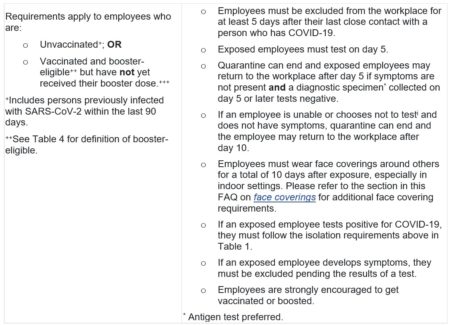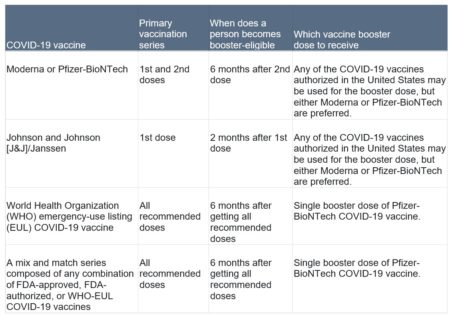Yesterday, January 6, 2022, the Division of Occupational Safety and Health (Cal/OSHA), under the California Department of Industrial Relations, released clarifying Frequently Asked Questions regarding the recent changes to the California Department of Public Health (CDPH)-recommended COVID-19 isolation and quarantine periods affecting the Emergency Temporary Standards (ETS). Listed below are the clarifying changes.
1. Q: How do the January 6, 2022, changes to CDPH’s recommended isolation and quarantine periods affect the ETS?
A: In December of 2020, the Governor issued Executive Order N-84-20, which states that the recommended isolation and quarantine periods in the ETS (also called “exclusion periods” in the ETS) will be overridden by any applicable isolation or quarantine recommendation by the CDPH or, if applicable, the local health department with jurisdiction over the workplace, if the periods in the ETS are longer than those recommended by the CDPH or local health department. If the CDPH and local health department isolation and quarantine recommendations differ, the required exclusion period under the ETS is the longer of the two.
This means that, with only one exception noted below, the new isolation and quarantine recommendations from CDPH replace the exclusion periods and return-to-work criteria in sections 3205(c)(9) and 3205(c)(10) of the ETS. The exclusion requirements are as follows in the tables below.
The June 17, 2021, ETS remains in effect until January 14, 2022. Until then, the quarantine rules for fully vaccinated workers set forth therein continue to apply because exclusion periods for this group of workers is not longer than those recommended by the updated CDPH guidance. However, employers are encouraged to review and begin the process of implementing the CDPH recommendations before then. The CDPH recommendations will replace exclusion periods and return-to-work criteria for all workers when the second readoption of the ETS takes effect on January 14, 2022.
Table 1: Exclusion Requirements for Employees Who Test Positive for COVID-19 (Isolation)

Table 2: Employees Who Are Exposed to Someone with COVID-19 (Quarantine)

+++Employers are not required to exclude asymptomatic employees in this category if:
-
- A negative diagnostic test* is obtained within 3-5 days after last exposure to a case;
- Employee wears a face covering around others for a total of 10 days (please refer to the section in this FAQ on face coverings for additional face covering requirements); and
- Employee continues to have no symptoms.
Table 3: Employees Who Are Exposed to Someone with COVID-19
(No Quarantine Required)

Table 4: California COVID-19 Vaccines Booster Recommendations

In addition to the above, pursuant to section 3205(c)(10)(E), when an order to isolate, quarantine, or exclude an employee is issued by a local or state health official, the employee shall not return to work until the period of isolation or quarantine is completed or the order is lifted even if the order exceeds the specified exclusion requirements in the ETS or CDPH recommendation.
2. Q: What if tests cannot be obtained following a close contact?
A: If employees covered by Table 2 cannot be tested as required, quarantine must continue for at least 10 days as explained in the table. If employees covered by Table 3 cannot be tested on day 5, employers should follow the ETS. For vaccinated close contacts, as of January 14, 2022, that means wearing a face covering and maintaining six feet of distance for 14 days following the close contact.
i Employers may require employees submit to viral testing for COVID-19. Please refer to the FAQ from DFEH for further information.
ii A fever is a measured body temperature of 100.4 degrees Fahrenheit or higher.
iii A fever resolves when 24 hours have passed with no fever, without the use of fever-reducing medications.
Update from the COVID-19 Public Health Guidance for K-12 Schools
The Safe Schools for All Team released the following changes to the COVID-19 Public Health Guidance for K-12 Schools on the following topics:
- Isolation for students (i.e., when a student has been infected with the virus, even if they don’t have symptoms): As has always been the case,CDPH K-12 Schools guidance (in Section 10) recommends that individuals follow the general CDPH guidance regarding isolation. Thus, per the now-updated general CDPH guidance, for “Everyone, regardless of vaccination status, previous infection or lack of symptoms… Isolation can end after day 5 if symptoms are not present or are resolving and a diagnostic specimen collected on day 5 or later tests negative.” See the general guidance for more.
- Quarantine for students (i.e., when a student might have been exposed to the virus and may or may not be infected):The current CDPH K-12 guidance regarding modified and standard quarantines remains unchanged at this time. That said, we are actively reviewing new U.S. Centers for Disease Control guidance (issued yesterday, Jan 4, 2021) and hope to provide updates soon.
- Staff: As has been the case, employers are subject to the Cal/OSHA COVID-19 Prevention Emergency Temporary Standards (ETS) but Executive Order N-84-20 is still active. It is our understanding that Cal/OSHA will provide additional clarifications via a forthcoming statement.

